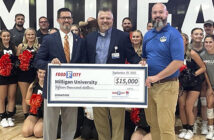
Caroline and Luke Bader enjoy one of Hands On’s newest areas, the Imagination Playground. Photo by Jeff Keeling
By Jeff Keeling
Picture a 10-year-old leaving the fascination of Hands On! Regional Museum’s world-record Tesla coil exhibit, her head full of curiosity about electricity, walking 100 feet or so, and viewing the latest Miocene-era fossils unearthed at the Gray Fossil Site. It could make using one’s inside voice and refraining from running quite a test – and it could happen within two years.
Hands On! may enter a new epoch next year. If the new age dawns, the 28-year-old children’s museum, and the fossil site and natural history museum run by East Tennessee State University – and ultimately their visitors – should benefit, leaders of both institutions say.
“To have our vision combined with the constant, ongoing dig site, where they’re discovering new things all the time, creates a master plan that is remarkably unique to this area,” Hands On! Director Andy Marquart said last week. “I think the synergies are so opportunistic for both entities that we’re both comfortable with moving forward at this point in time.”
Years after first talking about a new, larger building, the children’s museum is in formal negotiations with ETSU to co-locate Hands On! in Gray. Thanks to about 12,000 square feet of available unused space there, such a move could roughly halve the estimated $15 million cost for phase I of the new Hands On! (30,000 square feet including about 15,000 square feet of exhibit space).
Marquart said while the programmatic advantages are clear and significant, money certainly plays a role.
“I truly believe the museum would work wherever we put it with the right content,” Marquart said (the pre-ETSU plan called for building in downtown Johnson City, where the current museum is). “What this comes down to is economic feasibility to have space. We have a fiduciary responsibility to look at fulfilling a plan (the ETSU partnership) that would be a 20-year master plan buildout, and at the same time save between $6 and $8 million doing it.”
Marquart, at the behest of his board, made a proposal to ETSU several months ago, and it’s being fleshed out, vetted and exchanged between the two parties. The plan being considered envisions a new building at Gray for Hands On! eventually, but in the meantime the museum would soon start running the fossil museum’s day-to-day operations, and within 18 months or so relocate its current downtown Johnson City operations to the annex space.
With the caveat that unforeseen technicalities could nix the deal, leaders from both parties talk enthusiastically about the possibilities the partnership – which ETSU hopes could be mostly ironed out by the end of this year or early January – could bring them both.
The essence of the partnership, as envisioned, would leave Hands On! operating both museums’ exhibits starting as early as July. Hands On!’s current exhibits would stay in downtown Johnson City for an additional year before being completely moved to the annex space by summer 2017. Revenues from all museum activities at Gray would go to Hands On!, which would oversee staffing and other day-to-day affairs. ETSU would focus on research and academics, while still providing a very important component to the museum experience.
“I believe what’s been put forth allows ETSU to focus on research, the academic component, which is what we’re most focused on as a university,” ETSU Chief of Staff for External Operations Jeremy Ross said last week. “The components of the fossil site that are relative to a welcome center, a museum, things of that sort, are expertise that Hands On! is focused on.”
It’s a vision, Marquart said, that offers Hands On! the most realistic path toward something museum leaders have discussed since 1999 – a new, larger building to take the museum to the next level. Within months of Marquart’s arrival in August 2013, the museum commissioned a study – the “Gyroscope” report – that compared Hands On! and this region with comparable metros that have children’s museums. It also laid out information about a new building and how to get there.

Casey Crumly, right, looks at a find with Gabrielle Puckett during paleo camp in July at the
Gray Fossil Site. Photo by Sarah Colson
The report was based on a new building downtown, but provided an adequate framework of data for Hands On! leaders to consider the ETSU option. That didn’t happen, though, until they had shopped the report’s results around with an eye on downtown and failed to gain a tremendous amount of traction, Marquart said.
Since the ETSU possibility came up, though, “we have found that a lot of private individuals support this opportunity.”
One thing is for sure, he added. The museum’s current location is untenable for much longer, and was never meant to be a permanent home. It’s not ADA accessible, has no designated parking, and doesn’t have bathrooms on the main floor. Leadership has added several new exhibits since Marquart came on board, brought in the highly successful traveling Body Exhibit earlier this year, and done the best it could with facilities that have long been inadequate, he said.
“When you look at numbers for other facilities around the country with equal populations, they’re consistently much higher, and especially with regard to membership and repeat visitation,” Marquart said. “We’re probably a once-a-year destination, and we want to move to being a centerpiece and community fabric where we constantly have events and things going on, and educational opportunities that raise the level of participation within the region.”
Reaching those goals could be easier – and certainly more affordable – if the fossil site partnership pans out, both Marquart and Hands On! board chair Dr. Robbie Anderson said.
“We think having this opportunity will cement that concept that we are going to be a regional educational facility,” Anderson said. “I think it’s going to enhance the mission for both sites and organizations, and I think it will make Hands On! a viable educational experience on through the upper grades.
“Sometimes I think when people think about Hands On! they think of the wonderful experiences for young children. I think by exploring this partnership, if it does come to fruition, we’re going to be able to provide a wonderful educational experience for students of all ages.”
In its latest iteration, the proposed agreement expects Hands On! to begin construction of the new building within five years of the agreement. The financial advantages to Hands On! are obvious, but ETSU’s Ross said he and other university leaders are excited about what Hands On! can bring to the partnership as well.
“They have 70,000, 80,000 constituents, along with schools, they market to and communicate with, and it allows us to interact with these constituents through our professors, our research,” Ross said. “I think it gives greater exposure to ETSU, to paleontology and to the research work we do, and I believe our activities will also drive people to interact and engage with Hands On!
“There are synergies on both sides, there are levels of expertise and points of focus on each side, and now there’s an opportunity to take various affinity groups and constituencies and use them to drive a larger vision.”
Marquart agrees, and envisions the combined space operating as a seamless whole rather than two distinct museums, even as the integrity of the dig sites and research is protected.
“We found their ultimate strategic plan and ours aligned in many ways,” he said.
“The number one goal for us is to provide an experience that everybody can appreciate and that Hands On! is known for, and remain completely autonomous regardless of our location.”



